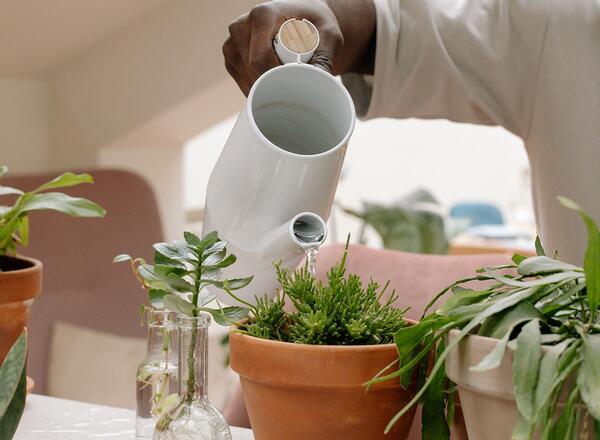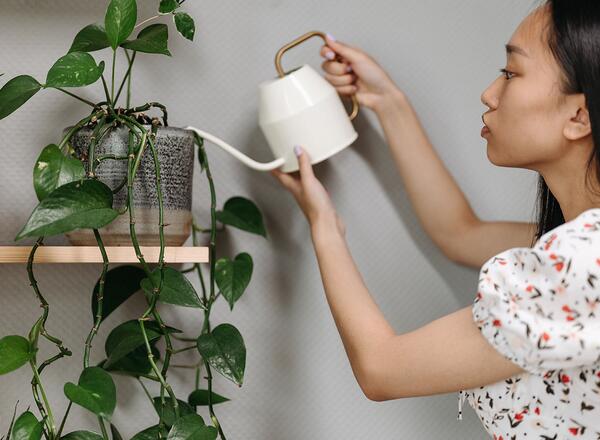Plants grown in containers need frequent watering as the containers dry fast. Watering on a daily basis is necessary to provide adequate moisture for plant growth. Apply enough water to reach the bottom of the container. Allow the excess to drain out through drainage holes. Avoid wetting the leaves when watering as this will encourage development of foliar disease. Try not to allow the containers to dry out completely between watering as this will lead to flower and fruit drop. Do not over water the plants as the container will be waterlogged and the roots will lack oxygen leading to poor growth and eventually, perhaps, the plant's death.

Because containerized plants have a very limited soil volume, proper watering and fertilizing are critical in maintaining an attractive pot throughout the growing season. How often you need to water a container varies depending on the time of the year, location of the container, how long the container has been planted, type of container, and type of plant material. There are no hard and fast rules when it comes to watering. That is why you have to be watching your containers on a regular basis and understand the requirements of the plants you choose to put in the containers. While there are all kinds of water meter devices on the market they are really no substitute for observing the plant and using your finger to see how moist or dry the soil really is.
Watering should be done when the plants need water and preferably before they start to show signs of wilting severely. Quality and overall heath of the plant are greatly affected by allowing the plant to wilt severely. Some plants can tolerate and prefer dry soils and if kept too moist will often decline. Succulents are an example versus tropicals. Understand the plant you have. Water it based on its needs and not some general rule of thumb.
When it comes to rules of thumb the best way to tell if a plant needs water is to feel the soil. And if the first inch or so of the soil is dry, water. Apply enough water each time so the whole soil ball becomes moist. This means using enough water each time so water starts to drip out of the drainage holes. This assures you have gotten the whole soil mass moist, and it also assures you have gotten some leaching of the soil.
Leaching means you move away any harmful build up of soluble salts in the soil with water. Soluble salts can come from fertilizer and water sources and leaching just prevents it from building up and causing plant damage. Damage can take the form of burned leaf margins and injured roots. Use well water or naturally collected water source and not a source of water that has been softened. Watering can be done using a hand held watering wand or if you have a lot of containers located in the same general area, drip irrigation systems can be set up to make watering more convenient and less time consuming.

Keep in mind that when using soilless potting mixes, they have a tendency to shrink away from the pot edges if allowed to dry out excessively. If this happens, rewetting becomes difficult because water tends to flow through the pot in the space between the pot and media leaving the media dry. If the container has dried out to this point, repeated watering will be needed to rehydrate the soil. If possible, immerse the container in a bucket or sink filled with water and leave it there allowing water to be absorbed through the holes in the bottom of the container. When you see moisture on the surface of the media, you know the soil is now moist.
To help retain moisture in the soil and to lengthen the interval between waterings slightly, you can incorporate one of the many gels available. This polymer based product looks like granular rock salt when dry and is mixed into the media before planting. Always read label directions for amounts to use based upon the size of the container and always mix the dry product. When these crystals are subjected to moisture, they expand taking on the consistency of gelatin. They now become reservoirs for water that a plant can use when the soil itself becomes dry. These products do not eliminate the need for timely watering. They just provide a slight cushion.
If you are growing perennials or evergreens in containers, be sure they are well watered before storing or covering them for the winter. Evergreens are especially vulnerable to winter desiccation if soils dry out during the winter.